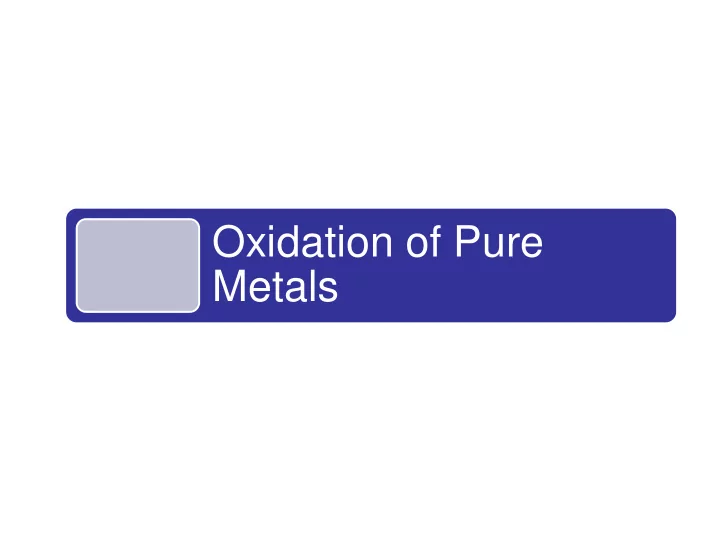

Oxidation of Pure Metals
Classification of Metals • Nobel Metals – Gold, Platinum, Palladium Based upon their • Transition Metals – Relatively moderate Oxidation- Fe, Oxidation Resistance Ni, Co etc. • Alkali/Alkali earth metals – High oxidation • Al, Cu, – Low temperature Based upon their • Iron, Nickel, Cobalt - Intermediate Temperatures Temperature of • Pt, Pd, Gold and of course Ta, W, Re – Very high application Temperatures ( Vacuum or inert environment) • Transitions Elements – used as structural elements ( Based Upon the negligible oxygen dissolution) Dissolution of Oxygen • Elements such as Ti, Ta, Nb, Zr and Hf ( High Oxygen during Oxidation dissolution) Based upon the • Ni – Single layer oxide Formation Complexity of Oxide • Co – Double layer Oxide Formation • Fe – Multi-layer Oxide Formation Formation
Oxidation of Nickel Simplest Element – forms a single oxide well adherent Oxidation very much dependent on impurity content. A Ni with purity more than 0.002% shows a well adherent single NiO layer which grows by outward diffusion of Ni ++ ions. Impure Ni ( mainly C impurity) shows two oxide layer – an outer compact layer formed by outward diffusion of Ni ++, and an inner loose oxide formed by inward diffusion of O -- . Parabolic Oxidation rate of Ni at 600 o C is about half of that at 1000 o C. This is mainly due to that domination of grain boundary diffusion at lower temperature compared to manly volume diffusion at 1000 o C. This discrepancy can be removed if the Wagners’ theory is modified by including GB diffusion
Oxidation of Cobalt Cobalt is another very important metal for high temperature application. Depending upon the temperature and the partial pressure of oxygen, it oxidizes to form either CoO or a two layered scale, consisting of CoO and Co 3 O 4 . CoO has a NaCl type structure and is a p -type with cation vacancies. Markers tests confirmed the outward diffusion of cobalt ions. Oxidation constant varies as a function of pressure between 940 to 1300 o C at oxygen pressure between 10 -4 to 0.7 atm. Oxidation of cobalt to CoO at high temperatures is a good example of the applicability of the ideal Wagner model. This could be due to the large concentration of point defects, which suppress the importance of impurity effects, relative importance of grain boundary diffusion and hence makes it comparatively easy to study the defect dependent properties of CoO. Co 3 O 4 is a spinel type oxide and in a two layer scale it is always at the oxide gas interface. Also, the thickness of this oxide is very small compared to CoO. Because of its lower thickness the overall oxidation may still be governed by diffusion through the CoO layer
Oxidation of Cobalt Co 3 O 4 CoO Parabolic rate constants as a function of pressure 750 o C in Oxygen for 10h
Oxidation of Iron Iron on oxidation forms a scale, which is a mixture of three oxides, wustite, FeO; magnetite, Fe 3 O 4 and haematite, Fe 2 O 3 . The composition of the scale varies with temperature and with the oxygen partial pressure as shown in Fe-O phase diagram. FeO is formed only above 570 o C. Below which only magnetite and haematite are formed. Wustite, FeO is a p -type oxide, with metal vacancies. It exists over a wide range of stoichiometry, from Fe 0.95 O to Fe 0.88 O at 1000 o C. With such high cation vacancies, the mobility of cations and electrons via metal vacancies and electron holes is extremely high. The magnetite, Fe 3 O 4 , has inverse spinel structure, that is all the Fe +2 ions and half of thetrivalent Fe +3 ions are occupied by octahedral sites, and the other half of the trivalent ions Fe +3 , occupy tetrahedral sites. Defects occur on both the sites and consequently, iron ions Haematite, Fe 2 O 3 , exists in the a and ?forms, which are rhombohedral and cubic in structure respectively. Generally, at T > 400 o C, Fe 3 O 4 is oxidized to α -Fe2O3. In the rhombohedral form, the oxygen ions exist on a close packed hexagonal arrangement with iron ions in interstices. In general, Fe 2 O 3 behaves as an n -type semiconductor, but evidence on the possible migration of cations is also there.
Phase Diagram of Iron with oxygen
Mechanism of Iron Oxidation
Multi Layer Oxidation Growth of both the layers in a two layered scale is diffusion controlled. The growth occurs by outward movement of cations. The flux of cations in each oxide is assumed to be independent of distance; and Each oxide exhibits predominantly electronic conductivity. Local equilibrium exists at the phase boundaries.
A metal M oxidising to form two oxides of the type MaO and MbO Let molar volumes of these oxides are V a and V b and thicknesses x a and x b.and K a and K b their individual parabolic rate constants and and K is the overall parabolic rate constant of the metal then the rates of oxidation of individual layer formation and that of total oxidation reaction are given by:
Recommend
More recommend